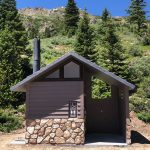The legend of Lenado
Aspen, CO Colorado
It may be somewhat presumptuous of me to talk about Lenado, as some of the residents are understandably quite reticent about the place, but the town has been a part of my life since I was a very young child. Lately, I’ve run into several unique people who used to live in or around Lenado and who knew me or my family from days gone by.
In the 1880s, Lenado was born a mining town, not in the commodity of silver as many erroneously believe, but as a producer of lead and zinc. However, her destiny was to be a lumber camp and almost from the beginning, there are tales of the forests above Lenado be-ing utilized for sawmill inventory. Actually, I don’t know if Lenado, more correctly pronounced [Le-nya’-do], was ever actually a town, but it did have a post office (sporadically) from 1891 until 1906.
My maternal grandmother, Nellie Sloss, and her sister, Julia Stapleton, both Aspen natives and tough, pioneer women with literary talents, taught school there in the 1930s and ’40s. They loved the place, and many summer camping expeditions led us straight to Lenado. I’d lie there in my sleeping bag, watching the intense beauty of the stars above and listen to story after story of their experiences. Of course, I don’t remember much about those stories, other than the ones about bears and unwary campers that always seemed to find their way into the campfire conversations. The old schoolhouse is still there.
In the 1950s, the U.S. Forest Service authorized the building of a much-improved road to the top of Larkspur Mountain and sawmill activity at Lenado increased dramatically. People we had never seen before were continually driving up and down the Woody Creek road and life, at least for us kids, became more interesting. Huge logging trucks, driven by Mick Bogue and his son Ron, began hauling both overflow logs and rough-cut lumber to other locales for processing and sale. There was a throng of kids living in Lenado then, and we always felt like we had a lot of good neighbors, although in reality about the only time we ever saw them was on the school bus.
The Red Mountain Cattlemen’s Association, owners of the Hunter Creek grazing rights, kept a cow camp there for most of my growing up years. When I was 12, my father bought the Lenado cattle grazing permit from Henry Stein’s Mill Iron Ranch, and, from then on, my life became more entwined with Lenado than it ever had been. Places like Hannon Creek, Casady Creek, Johnson Creek, Wilbur Gulchand others became the stuff of my summer existence and kept me away from home many days and nights, out on the open range.
If you lived in Lenado in those days, life was not necessarily idyllic and pristine, not like you might think. For many, accommodations were small shacks, some of which still exist, and the plumbing consisted of an outhouse and a bucket to carry water from the creek. Everyone seemed to make it work, and there weren’t any stories in the local paper about unrest at Lenado.
After the sawmill closed down, sometime in the late ’60s, the place began looking for a new identity. Some of the old-time lumber families stayed on, such as Flogas and Marsing, mostly because they owned property, but the closing coincided with the hippie era and squatters with frontier notions moved into some of the old abandoned shacks. Since then, at least one unsolved murder has been committed within its proximity, the hands and head severed from the corpse, and rumors used to circulate concerning illicit drug activity, as if that never occurred in Aspen.
Lenado is, without question, a quiet and interesting enclave straddling Woody Creek. There are still a few independent and free-thinking souls living there, who decidedly appreciate you driving and riding slowly as you pass through.
New Colorado gun law triggers response in Pitkin County, Basalt
Colorado’s new law introduces sweeping restrictions on the manufacture, sale, and ownership of certain semiautomatic firearms and devices designed to increase firing speed.









